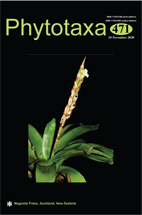Abstract
A new species, Melnikomyces longisporum sp. nov. was isolated from forest litter in Guizhou Province, China. Phylogenetic analysis based on a combined nuclear ribosomal markers (SSU, ITS, and LSU) and protein coding genes (ACT1, TUB2, and TEF1-α) sequence data indicated that this strain belonged to the genus Melnikomyces but it constituted a distinct lineage and represented herein as a novel taxon. Morphological examination showed that it can be distinguished from known Melnikomyces species by its longer branched conidiophores, and longer verruculose conidia.
References
<p class="Reference">Crous, P.W., Shivas, R.G., Quaedvlieg, W., van der Bank, M., Zhang, Y., Summerell, B.A., Guarro, J., Wingfield, M.J., Wood, A.R., Alfenas, A.C., Braun, U., Cano-Lira, J.F., Garcia, D., Marin-Felix, Y., Alvarado, P., Andrade, J.P., Armengol, J., Assefa, A., den Breeyen, A., Camele, I., Cheewangkoon, R., De Souza, J.T., Duong, T.A., Esteve-Raventos, F., Fournier, J., Frisullo, S., Garcia-Jimenez, J., Gardiennet, A., Gene, J., Hernandez-Restrepo, M., Hirooka, Y., Hospenthal, D.R., King, A., Lechat, C., Lombard, L., Mang, S.M., Marbach, P.A., Marincowitz, S., Marin-Felix, Y., Montano-Mata, N.J., Moreno, G., Perez, C.A., Perez Sierra, A.M., Robertson, J.L., Roux, J., Rubio, E., Schumacher, R.K., Stchigel, A.M., Sutton, D.A., Tan, Y.P., Thompson, E.H., van der Linde, E., Walker, A.K., Walker, D.M., Wickes, B.L., Wong, P.T. & Groenewald, J.Z. (2014) Fungal Planet description sheets: 214–280. <em>Persoonia</em> 32: 184–306.</p><p class="Reference"> <a href="https://doi.org/10.3767/003158514X682395">https://doi.org/10.3767/003158514X682395</a></p><p class="Reference">Choi, Y.W., Hyde, K.D. & Ho, W.H. (1999) Single spore isolation of fungi. <em>Fungal Diversity</em> 3: 29–38.</p><p class="Reference">Chomnunti, P., Hongsanan, S., Aguirre-Hudson, B., Tian, Q., Persoh, D., Dhami, M.K., Alias, A.S., Xu, J., Liu, X., Stadler, M. & Hyde, K.D. (2014) The sooty moulds. <em>Fungal Diversity</em> 66: 1–36.</p><p class="Reference"> <a href="https://doi.org/10.1007/s13225-014-0278-5">https://doi.org/10.1007/s13225-014-0278-5</a></p><p class="Reference">Crous, P.W., Mohammed, C., Glen, M., Verkley, G.J.M. & Groenewald, J.Z. (2007) Eucalyptus microfungi known from culture. 3. Eucasphaeria and Sympoventuria genera nova, and new species of Furcaspora, Harknessia, Heteroconium and Phacidiella. <em>Fungal Diversity</em> 25: 19–36.</p><p class="Reference">Carbone, I. & Kohn, L.M. (1999) A method for designing primer set speciation studies in filamentous ascomycetes. <em>Mycologia</em> 91: 553–556.</p><p class="Reference"> <a href="https://doi.org/10.1080/00275514.1999.12061051">https://doi.org/10.1080/00275514.1999.12061051</a></p><p class="Reference">Gargas, A. & Taylor, J.W. (1992) Polymerase chain reaction (PCR) primers for amplifying and sequencing nuclear 18S rDNA from lichenized fungi. <em>Mycologia</em> 84: 589–592.</p><p class="Reference"> <a href="https://doi.org/10.1080/00275514.1992.12026182">https://doi.org/10.1080/00275514.1992.12026182</a></p><p class="Reference">Glass, N.L. & Donaldson, G.C. (1995) Development of primer sets designed for use with the PCR to amplify conserved genes from filamentous ascomycetes. <em>Applied and Environmental Microbiology</em> 61: 1323–1330.</p><p class="Reference"> <a href="https://doi.org/10.1128/AEM.61.4.1323-1330.1995">https://doi.org/10.1128/AEM.61.4.1323-1330.1995</a></p><p class="Reference">Hernández-Restrepo, M., Giraldo, A., van Doorn, R., Wingfield, M.J., Groenewald, J.Z., Barreto, R.W., Colmán, A.A., Mansur, P.S.C. & Crous, P.W. (2020) The Genera of Fungi–G6: <em>Arthrographis</em>, <em>Kramasamuha</em>, <em>Melnikomyces</em>, <em>Thysanorea</em>, and <em>Verruconis</em>. <em>Fungal Systematics and Evolution </em>6: 1–24.</p><p class="Reference"> <a href="https://doi.org/10.3114/fuse.2020.06.01">https://doi.org/10.3114/fuse.2020.06.01</a></p><p class="Reference">Huanraluek, N., Phukhamsakda, C., Senwanna, C., Hongsanan, S., Jayawardena, R.S., Bhat, D.J. & Hyde, K.D. (2019) <em>Verruconis heveae</em>, a novel species from <em>Hevea brasiliensis</em> in Thailand. <em>Phytotaxa</em> 403 (1): 47–54.</p><p class="Reference"> <a href="https://doi.org/10.11646/phytotaxa.403.1.4">https://doi.org/10.11646/phytotaxa.403.1.4</a></p><p class="Reference">Hall, T.A. (1999) BioEdit: a user-friendly biological sequence alignment editor and analysis program for Windows 95/98/NT. <em>Nucleic Acids Symposium Series</em> 41: 95–98.</p><p class="Reference">Kumar, S., Stecher, G., Li, M., Knyaz, C. & Tamura, K. (2018) MEGA X: Molecular Evolutionary Genetics Analysis across Computing Platforms. <em>Molecular Biology and Evolution</em> 35: 1547–1549.</p><p class="Reference"> <a href="https://doi.org/10.1093/molbev/msy096">https://doi.org/10.1093/molbev/msy096</a></p><p class="Reference">Larsson, A. (2014) AliView: a fast and lightweight alignment viewer and editor for large data sets. <em>Bioinformatics</em> 30: 3276–3278.<br /> <a href="https://doi.org/10.1093/bioinformatics/btu531">https://doi.org/10.1093/bioinformatics/btu531</a></p><p class="Reference">Machouart, M., Samerpitak, K., de Hoog, G.S. & Gueidan, C. (2014) A multigene phylogeny reveals that <em>Ochroconis</em> belongs to the family <em>Sympoventuriaceae</em> (Venturiales, Dothideomycetes). <em>Fungal Diversity</em> 65: 77–88.</p><p class="Reference"> <a href="https://doi.org/10.1007/s13225-013-0252-7">https://doi.org/10.1007/s13225-013-0252-7</a></p><p class="Reference">Miller, M.A., Pfeiffer, W. & Schwartz, T. (2010) Creating the CIPRES Science Gateway for inference of large phylogenetic trees. <em>Proceedings of the Gateway Computing Environments Workshop</em> (GCE): 1–8.</p><p class="Reference"> <a href="https://doi.org/10.1109/GCE.2010.5676129">https://doi.org/10.1109/GCE.2010.5676129</a></p><p class="Reference">Posada, D. (2008) jModelTest: phylogenetic model averaging. <em>Molecular Biology and Evolution</em> 25: 1253–1256.</p><p class="Reference"> <a href="https://doi.org/10.1093/molbev/msn083">https://doi.org/10.1093/molbev/msn083</a></p><p class="Reference">Rozewicki, J., Li, S., Amada, K.M., Standley, D.M. & Katoh, K. (2019) MAFFT-DASH: integrated protein sequence and structural alignment. <em>Nucleic Acids Research</em> 47: 5–10.</p><p class="Reference"> <a href="https://doi.org/10.1093/nar/gkz342">https://doi.org/10.1093/nar/gkz342</a></p><p class="Reference">Ronquist, F., Teslenko, M., van der Mark, P., Ayres, D.L., Darling, A., Hohna, S., Larget, B., Liu, L., Suchard, M.A. & Huelsenbeck, J.P. (2012) MrBayes 3.2: efficient Bayesian phylogenetic inference and model choice across a large model space. <em>Systematic Biology</em> 61: 539–542.</p><p class="Reference"> <a href="https://doi.org/10.1093/sysbio/sys029">https://doi.org/10.1093/sysbio/sys029</a></p><p class="Reference">Samerpitak, K., Gerrits van den Ende, B.H., Stielow, J.B., Menken, S.B. & de Hoog, G.S. (2016) Barcoding and species recognition of opportunistic pathogens in <em>Ochroconis</em> and <em>Verruconis</em>. <em>Fungal Biology</em> 120: 219–230.</p><p class="Reference"> <a href="https://doi.org/10.1016/j.funbio.2015.08.010">https://doi.org/10.1016/j.funbio.2015.08.010</a></p><p class="Reference">Samerpitak, K., Van der Linde, E., Choi, H.J., Gerrits van den Ende, A.H.G., Machouart, M., Gueidan, C. & de Hoog, G.S. (2014) Taxonomy of <em>Ochroconis</em>, genus including opportunistic pathogens on humans and animals. <em>Fungal Diversity</em> 65: 89–126.</p><p class="Reference"> <a href="https://doi.org/10.1007/s13225-013-0253-6">https://doi.org/10.1007/s13225-013-0253-6</a></p><p class="Reference">Stamatakis, A. (2014) RAxML version 8: a tool for phylogenetic analysis and post-analysis of large phylogenies. <em>Bioinformatics</em> 30: 1312–1313.</p><p class="Reference"> <a href="https://doi.org/10.1093/bioinformatics/btu033">https://doi.org/10.1093/bioinformatics/btu033</a></p><p class="Reference">Swofford, D.L. (2003) PAUP*. Phylogenetic analysis using parsimony (*and other methods), Version 4.0b10. Sinauer Associates, Massachusetts.</p><p class="Reference">Vilgalys, R. & Hester, M. (1990) Rapid genetic identification and mapping of enzymatically amplified ribosomal DNA from several Cryptococcus species. <em>Journal of Bacteriology</em> 172: 4238–4246.</p><p class="Reference"> <a href="https://doi.org/10.1128/JB.172.8.4238-4246.1990">https://doi.org/10.1128/JB.172.8.4238-4246.1990</a></p><p class="Reference">Wijayawardene, N.N., Hyde, K.D., Lumbsch, H.T., Liu, J.K., Maharachchikumbura, S.S.N., Ekanayaka, A.H., Tian, Q. & Phookamsak, R. (2018) Outline of Ascomycota: 2017. <em>Fungal Diversity</em> 88: 167–263.</p><p class="Reference"> <a href="https://doi.org/10.1007/s13225-018-0394-8">https://doi.org/10.1007/s13225-018-0394-8</a></p><p class="Reference">White, T.J., Burns, T. & Lee, S. (1990) Amplification and direct sequencing of fungal ribosomal RNA genes for phylogenetics. In: Innis, M.A., Gelfand, D.H., Sninsky, J.J. & White, T.J. (Eds.) <em>PCR protocols: a guide to methods and applications.</em> Academic Press, New York, USA, pp. 315–322.</p><p class="Reference"> <a href="https://doi.org/10.1016/B978-0-12-372180-8.50042-1">https://doi.org/10.1016/B978-0-12-372180-8.50042-1</a></p><p class="Reference">Zhang, Y., Crous, P.W., Schoch, C.L., Bahkali, A.H., Guo, L.D. & Hyde, K.D. (2011) A molecular, morphological and ecological re-appraisal of Venturiales–a new order of Dothideomycetes. <em>Fungal Divers</em> 51: 249–277.</p><p> <a href="https://doi.org/10.1007/s13225-011-0141-x">https://doi.org/10.1007/s13225-011-0141-x</a></p>

